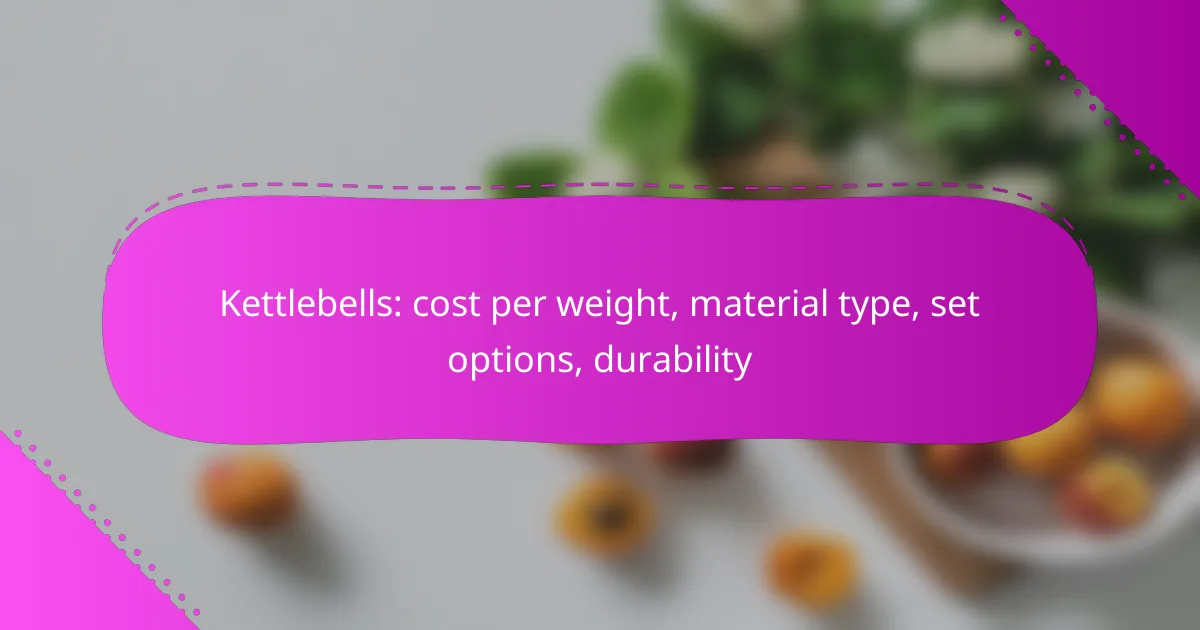Kettlebells are a versatile fitness tool, with costs varying between AUD 2 to AUD 5 per kilogram depending on factors like material, brand, and weight. They are typically made from cast iron, vinyl-coated, or competition-grade materials, each offering unique benefits in terms of durability and grip. When selecting a kettlebell set, consider your fitness goals, budget, and available space, as options range from single kettlebells to adjustable and complete sets.

What is the cost per weight of kettlebells in Australia?
The cost per weight of kettlebells in Australia varies based on factors such as material, brand, and weight. Generally, you can expect to pay between AUD 2 to AUD 5 per kilogram, depending on these variables.
Average cost per kilogram
The average cost per kilogram for kettlebells in Australia typically falls within the range of AUD 3 to AUD 4. This price reflects standard cast iron kettlebells, which are the most common type. Premium materials or unique designs can increase this average significantly.
When considering your purchase, keep in mind that higher quality materials, such as competition-grade kettlebells, may cost more but offer better durability and performance.
Price ranges for different weights
Price ranges for kettlebells vary by weight category. For lighter kettlebells (up to 8 kg), prices usually start around AUD 30 and can go up to AUD 60. Medium weights (8 kg to 16 kg) typically range from AUD 50 to AUD 100.
Heavier kettlebells (over 16 kg) can cost between AUD 80 and AUD 200, depending on the brand and material. It’s wise to compare prices across different retailers to find the best deals.
Cost comparison of popular brands
Popular kettlebell brands in Australia include Kettlebell Kings, Rogue Fitness, and ProForm. Kettlebell Kings generally offers high-quality options starting at around AUD 3.50 per kilogram, while Rogue Fitness may charge slightly more due to their premium offerings.
ProForm tends to provide budget-friendly options, with prices starting closer to AUD 2.50 per kilogram. When selecting a brand, consider factors like warranty, customer reviews, and material quality to ensure you make a sound investment.

What material types are kettlebells made from?
Kettlebells are primarily made from three main material types: cast iron, vinyl-coated, and competition-grade materials. Each type offers distinct advantages and considerations regarding durability, grip, and suitability for different training styles.
Cast iron kettlebells
Cast iron kettlebells are the most traditional and widely used type. They are known for their durability and ability to withstand heavy use, making them ideal for strength training. Typically, these kettlebells have a rough texture that provides a good grip, although some users may prefer a smoother finish.
When purchasing cast iron kettlebells, consider their weight range, which usually spans from around 4 kg to over 32 kg. It’s advisable to start with a lighter weight if you’re new to kettlebell training, gradually increasing as your strength improves.
Vinyl-coated kettlebells
Vinyl-coated kettlebells feature a layer of vinyl that covers the cast iron core, providing a more colorful and aesthetically pleasing option. The vinyl coating helps protect floors from damage and reduces noise during workouts. However, they may not be as durable as their cast iron counterparts.
These kettlebells typically come in lighter weights, ranging from about 2 kg to 12 kg, making them suitable for beginners or those focusing on lighter, high-rep workouts. Ensure the grip is comfortable, as the coating can sometimes make them slippery when sweaty.
Competition kettlebells
Competition kettlebells are designed to meet specific standards set by governing bodies for competitive lifting. They are usually made from steel and have a uniform size regardless of weight, which helps maintain consistency in training. This type is favored by serious athletes and those preparing for competitions.
These kettlebells typically range from 8 kg to 32 kg and are often color-coded for easy identification. If you plan to compete, investing in competition kettlebells can be beneficial, as they allow you to practice with the same equipment used in events.

What are the best kettlebell set options available?
The best kettlebell set options vary based on your fitness goals, budget, and space. Popular choices include single kettlebell sets, adjustable kettlebell sets, and complete kettlebell sets, each offering unique advantages for different training needs.
Single kettlebell sets
Single kettlebell sets are ideal for beginners or those with limited space. They typically come in a range of weights, allowing users to choose one that suits their current fitness level. Prices for these sets can vary, generally starting from around $20 to $100 depending on the weight and material.
When selecting a single kettlebell, consider the weight that aligns with your strength and workout goals. A good rule of thumb is to start with a weight that allows you to perform 8-12 repetitions of an exercise with proper form.
Adjustable kettlebell sets
Adjustable kettlebell sets offer versatility by allowing users to change the weight according to their workout needs. These sets usually consist of a base kettlebell with removable weights, making them a space-saving option for home gyms. Prices typically range from $50 to $200.
When choosing an adjustable kettlebell, look for models that are easy to adjust and secure. This ensures safety during workouts and allows for quick transitions between exercises.
Complete kettlebell sets
Complete kettlebell sets include multiple kettlebells of varying weights, catering to a wide range of exercises and fitness levels. These sets are beneficial for those who want to perform progressive training or work out with multiple weights. Prices can range from $100 to $500 or more, depending on the number of kettlebells and their quality.
Investing in a complete kettlebell set is ideal for serious fitness enthusiasts or those looking to incorporate kettlebell training into their routine. Ensure that the set includes a variety of weights to accommodate different exercises and strength levels.

How durable are different kettlebell materials?
The durability of kettlebells varies significantly based on the material used. Understanding these differences can help you choose the right kettlebell for your workout needs and longevity expectations.
Durability of cast iron kettlebells
Cast iron kettlebells are known for their exceptional durability and resistance to wear. They can withstand heavy use without chipping or cracking, making them a popular choice for both home and gym settings.
However, they may rust if not properly maintained, so it’s advisable to keep them dry and occasionally apply a protective coating. In general, cast iron kettlebells can last for many years if cared for correctly.
Durability of vinyl-coated kettlebells
Vinyl-coated kettlebells offer a layer of protection that helps prevent damage from drops and scratches. This coating can enhance durability, but it may not be as robust as cast iron in terms of long-term wear.
While the vinyl can protect against minor impacts, it may chip over time, especially with heavy use. These kettlebells are often preferred for home use due to their aesthetic appeal and reduced noise during workouts.
Durability of competition kettlebells
Competition kettlebells are typically made from steel and designed to meet specific weight standards. Their durability is high, as they are built to endure rigorous training and competition environments.
These kettlebells often have a smooth finish, which can help prevent wear and tear. However, they can be more expensive than other types, so consider your budget and usage frequency when choosing them.

What factors should I consider when selecting kettlebells?
When selecting kettlebells, consider weight, material type, and storage options to ensure you choose the right equipment for your fitness goals and available space. Each factor plays a crucial role in your workout experience and overall satisfaction with your purchase.
Weight selection criteria
Choosing the right weight for kettlebells is essential for effective training. Beginners often start with weights ranging from 8 to 16 kg, while more experienced users may opt for 16 to 32 kg or more, depending on their strength levels and workout goals. It’s advisable to select a weight that allows you to perform exercises with proper form while still providing a challenge.
Consider your fitness level and the types of exercises you plan to perform. For instance, lighter kettlebells are suitable for high-rep workouts or endurance training, while heavier options are better for strength-focused routines. Investing in a set with adjustable weights can provide flexibility as your strength improves.
Material selection criteria
Kettlebells are typically made from cast iron, vinyl, or rubber-coated materials, each offering distinct advantages. Cast iron kettlebells are durable and provide a traditional feel, while vinyl or rubber-coated options are often more affordable and protect floors from damage. Choose a material that aligns with your training environment and personal preferences.
Additionally, consider the handle’s grip and texture. A smooth handle may be comfortable for some, but a textured grip can enhance control during dynamic movements. Ensure the material is suitable for your workout space, especially if you have hardwood or tiled floors.
Space and storage considerations
When selecting kettlebells, assess your available space for storage and workouts. Kettlebells can take up considerable room, especially if you choose a set with multiple weights. If space is limited, consider compact options or a single adjustable kettlebell that can cater to various weight needs.
For storage, look for kettlebell racks or designated areas that keep your workout space organized and safe. Avoid cluttering pathways to prevent accidents, and ensure that your kettlebells are easily accessible for your training sessions. Proper storage solutions can prolong the life of your equipment and enhance your workout experience.

How do kettlebell prices compare across brands?
Kettlebell prices vary significantly across brands, influenced by factors such as material, weight, and design. Generally, you can expect to pay anywhere from $1 to $3 per pound, depending on the brand and quality.
Comparison of Rogue Fitness kettlebells
Rogue Fitness offers a range of kettlebells that are known for their durability and high-quality materials. Their prices typically range from around $1.50 to $2.50 per pound, depending on the weight and specific model.
The kettlebells are made from cast iron and feature a powder-coated finish, which enhances grip and longevity. Rogue also provides options in different weights, from lighter kettlebells suitable for beginners to heavier ones for advanced users.
When considering a purchase, it’s essential to evaluate your fitness goals and choose a weight that aligns with your training needs. Rogue’s kettlebells are often praised for their balance and design, making them a popular choice among fitness enthusiasts.
